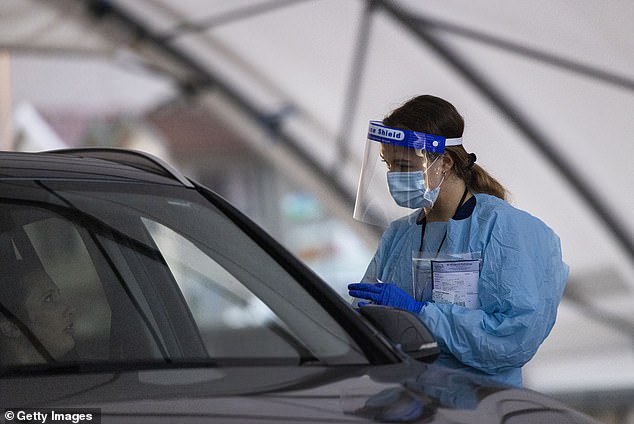Medical experts have warned of the potentially fatal return of dormant diseases as Australia finds itself in the midst of a “perfect storm” of disease and “vaccine fatigue” across the country.
Vaccination rates are so low in some areas that deadly diseases such as polio, tetanus and whooping cough could make a shocking and frightening comeback.
Vaccination rates in Queensland have fallen to levels not seen in decades, with some districts seeing only 80 per cent of children fully vaccinated against deadly diseases.
This figure is well below the 95 percent level generally accepted as a guarantee of herd immunity (which protects even those who are not vaccinated) and could lead to the deaths of children.
In parts of the Gold Coast and Sunshine Coast, polio vaccination rates of around 80 per cent are achieved, and about the same level for DTP vaccines, which cover diphtheria, tetanus and pertussis.
“If vaccination rates continue to fall in some areas, it certainly opens the door for a return of these diseases,” Griffith University infectious disease expert Professor Nigel McMillan told the Courier-Mail.
‘We know that the North Coast, Gold Coast and Wide Bay areas have some of the lowest DTP vaccination rates in the country.’
This year has already seen an increase in whooping cough cases, with 7,010 cases so far. The average number of cases between 2019 and 2023 was just 250.
Medical experts have warned of the potentially fatal return of dormant diseases, as Australia finds itself in the midst of a “perfect storm” of illness across the country (file image)
Queensland’s Chief Health Officer John Gerrard said childhood vaccination rates began to decline at the end of the public health response to the Covid pandemic.
“This is being seen not just in Queensland but across Australia and internationally,” he said. “There is vaccine fatigue and hesitancy across the developed world.”
“It is my responsibility to ensure that people have accurate information when making decisions related to their health care.”
Influenza is also having a devastating effect: more than 270,000 cases have already been recorded across Australia this year, likely leading to record hospitalisations in Queensland.
New South Wales has reported 140,978 cases as flu remained at a high level in August, while almost 47,000 Queenslanders have tested positive, with eight per cent of them – around 4,600 people – admitted to hospital.
That figure has already surpassed the total number of hospitalizations reported in all of 2019 by approximately 1,000 cases and is approaching the worst year on record: 2017, with 6,079 hospitalizations.
Robert Booy, an infectious disease expert with the Immunisation Coalition, said that while Queensland was particularly hard hit, “the whole of Australia is affected”.
“We’ve actually had a near-perfect storm, where not only has influenza increased but also other viruses like RSV and human metapneumovirus,” he said.
‘This can be explained by the fact that there was a drop in infections and a resurgence due to waning immunity and increased mixing.’
Professor Booy said Australians had become more susceptible to flu after Covid because social distancing rules had been removed.
He added that as the peak season winds down, many people have become complacent about getting flu shots.
“The season is starting to end, but that means there are still a lot of people getting infected right now,” he said.
“Even vaccination now in August can be beneficial, because people have not used protection.”

This year has seen a surge in whooping cough cases, with 7,010 cases so far. The average number between 2019 and 2023 was just 250 (file image)
Professor Booy said he expected the “moderately bad year” to kick in during August and September, the typical end of the flu season.
But he said many school-aged children and older people – those most at risk from the flu – would benefit if more people got vaccinated.
In its most recent report ending July 28, the federal government found that influenza A was the most commonly detected respiratory illness in every state in the country.
It surpassed both RSV and Covid, with 195,162 cases of Covid reported to the National Surveillance System for Notifiable Diseases so far this year.
The worst-affected states according to the Immunisation Coalition were New South Wales, with almost 150,000 cases this year, followed by Queensland and then Victoria.
New South Wales
The number of flu cases in New South Wales decreased in the week ending August 3 but remained at a high level, according to the New South Wales Department of Health.
Government data shows more than 6,300 people tested positive for flu that week, a 20 percent drop from the previous week.
That came after cases skyrocketed in July, with more than 16,000 testing positive, compared with just 8,000 in the same period last year.
Children up to four years old were the largest demographic, with the Western Sydney Local Health District recording the highest numbers.
Queensland
In Queensland, 7,142 people tested positive for flu during the week ending 11 August, compared with 7,282 cases reported the previous week.
Of those cases during the week to August 11, 254 people were admitted to hospital, mainly in the Brisbane metropolitan area.
At least 4,600 people have been admitted to hospital with flu so far this year, more than 1,200 of them in Brisbane.
Victory
Victoria has reported a total of 51,668 influenza cases so far this year, up to 12 August.
South Australia
So far this year to 9 August, South Australia has recorded more than 1,000 more cases of flu than in the same period last year.
In the week ending August 9, the South African government reported 1,286 cases of influenza, bringing the number of cases so far this year to 13,168.
Tasmania
Influenza activity remained at a moderate but decreasing level in Tasmania in the week ending 4 August with “widespread community circulation”.
That week, 203 people were reported to have tested positive for flu, or about 35.4 people per 100,000.
Western Australia
Western Australia reported an increase in cases of influenza and influenza-like illnesses in the week ending 28 July.

Queensland’s Chief Health Officer John Gerrard said the level of childhood vaccination rates began to plummet at the end of the public health response to the Covid pandemic. Pictured is an Australian health worker wearing personal protective equipment
During that week, the number of cases reported to the Department of Health increased by 19 percent to 969 cases and “remained above the seasonal threshold.”
However, so far this year, the number of reports and deaths from influenza was lower than the average of the previous five years, although hospitalizations were higher.
ACT
A total of 303 people reported testing positive for influenza between August 2 and 8, bringing the total number of cases so far this year to 3,533.


